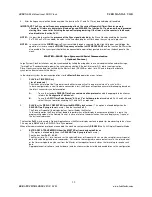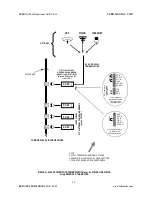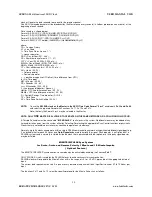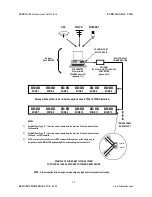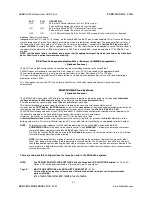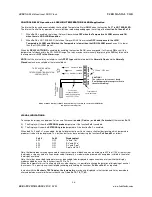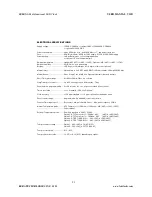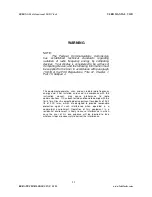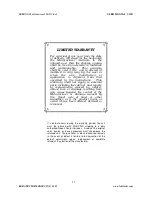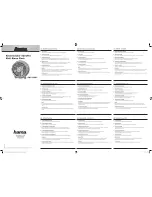
SELENA
Multifunctional LED Clock
USER MANUAL V32D
KERA TECHNOLOGIES INC. 2013
www.ledclocks.com
43
However, NOTE that:
1)
The SELENA Time Sync protocol,
and in some instances
also other protocols, MAY NOT ALLOW
the slave to sync
to the master signal from the 50th second of the previous till the 5th second of the next minute.
2)
When Fn 91 is enabled ( x5th Minute-Units sync ),
the slave will sync on the
5th minute of each 10-minute period
only
( i.e. 05th, 15th, 25th, 35th, 45th and 55th minute). The hours and the minute tens will not be affected.
3)
When Fn 90 is enabled ( sync the seconds only ),
this method will cause the zone to sync ONLY the SECONDS of
each minute. The hours and minutes of the zone time will not be affected.
4)
The SELENA Time Sync protocol,
and in some instances
also other protocols,
are usually allowed to sync the
slaves
ONLY on the 5th second of each 10-second period
except the 55th second ( i.e. 05th, 15th, 25th, 35th, and
45th second).
NOTE: It may be a good practice to enable both
Fn 90 and Fn 91
in the slaves to make sure that the slaves receive the
sync more often than just once every 10 minutes.
IMPORTANT:
If the particular zone requires that the zone minutes are not multiples of the Master 5-minute periods, the function
Fn 91
SHOULD NOT BE ENABLED.
Only the function
Fn 90
should be activated thus allowing the slave to sync to the
SECONDS ONLY
, and all minutes and hours should be initially set manually to within 1 minute of the real zone time.
Note, that in this configuration the sync
RANGE REPEATER
functions Fn53, 54 and 55 may also be used if necessary.
IMPORTANT: The TYPE “B” MULTI-ZONE configuration allows the slave zones to remain correctly offset from the
Master Time as long as either the supply power is present or the internal backup remains charged.
TEMPERATURE MONITORING and CONTROL with ALARM
( Optional Feature )
In all temperature monitoring or control configurations the function
Fn 61
must be enabled.
The functions
Fn 0
and
Fn 1
, when enabled, will cause the display to show the temperature sensed by one or two probes.
Up to 2 temperature probes may be connected to the clock terminals ( optional ).
For the ease of understanding, the probes are designated as
Internal
and
External
, even though they may be both wired
externally.
The clock is capable of monitoring and controlling ( optional ) the temperature sensed by the external and/or internal probe
(use function
Fn 27
to select the controlling probe) . The wired sensor probe(s) can be located at a significant distance away,
up to 500 feet ( 150 meters ) or, optionally, one probe may be installed on the side of the clock enclosure.
The system also stores the historical
Minimum and Maximum Temperature
readings that can be displayed
ON DEMAND
via the remote control ( by pressing the UP or DN key ).
In addition, by presetting the LOW and HIGH TEMPERATURE ALARMS, the user may activate the control operation of the
Internal Control Relay ( if installed ) and / or the Internal Alarm Buzzer
to indicate the ALARM status ( see
Fn 29
).
The temperature may be displayed in Fahrenheit units (
Fn 15
disabled ) or in Celsius units (
Fn 15
enabled ).
The temperature display resolution is normally 1F ( or 1C ), but in the displays with at least 6 digits it is possible to increase
the resolution to 0.1F ( or 0.1C ). This feature is controlled by the function
Fn 19.
TEMPERATURE PROBE type selection
The system can operate with two different types of NTC temperature probes specified as 50 Kohm or 100 Kohm , depending
upon the setting of the function
Fn 93
. Enable this function only if 100 Kohm probes are installed.
Note, that the higher resistance probe responds better to higher temperatures, while the lower resistance probe is better for
sensing of lower temperatures.
Temperature Test Specifications:
Temperature Test Range:
-40F ( -40C ) to +255F ( +124C )
Standard Resolution ( Fn19 disabled ): 1F or 1C
High Resolution ( Fn19 enabled ):
0.1F or 0.1C
Accuracy:
+/- 1%
NOTE, that the function
Fn 71
may be used to cause the system to NOT AVERAGE the temperature readings. This will
result in faster reaction to the temperature changes, but at the same time, the readings may become less stable.

